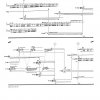Continuum
Continuum, sextet for percussion instruments (1965–66)
Les Percussions de Strasbourg
{slider=Continuum, sextet for percussion instruments /fragment/}
Wota's Percussion Group, „Musica Polonica Nova”, Wrocław 1996
{/slider}
Continnum was premiered at the Stockholm Festival in 1966 and was not heard in Poland until the 1972 “Warsaw Autumn”. The work is dedicated to the famous ensemble Les Percussions de Stasbourg.
As we can read in the commentary on the score, “the ensemble should be placed in the concert hall in a way that would enable all performers to see each other”. This is by no means a trivial matter, for the composer uses no fewer than 123 percussion instruments in his work. Tadeusz A Zieliński divides them into five categories, according to their sound characteristics:
1. dark, harsh, aggressive sounds generated e.g. by gongs, tam-tams, cymbals, timpani, bass drum, snare drums;
2. gentler sound of membranophones such as congas, tom-toms, bongos, tambourines;
3. pleasant wood sounds – claves, slapsticks, temple blocks, ratchets, maracas;
4. “sonorous” sounds made by bells, crotales, triangles, cowbells or bottles;
5. sounds made by struck bar instruments i.e glockenspiel, marimba, xylorimba or vibraphone.
The instruments are placed around the audience in six groups played by six performers (the composers also allows, albeit reluctantly, a stage version of the performance), but they are not segregated – each percussionist uses all types of instruments mentioned above. As a result the listeners are surrounded by sounds of various hues. Even if just one type of colour dominates at some point, it reaches the ears from all directions. On the other hand, when the colours change quickly, the listeners keep hearing contrasting sounds from different directions.
The sonic variety in Continuum is very sophisticated, because Serocki uses many unconventional means of producing sound, e.g. trills, glissandi, clusters obtained by means of special broad sticks, hitting the edges and sides of the instruments, playing with fingernails etc. This produces very attractive auditory phenomena, at times eerily similar to electronic sounds.
The form of the piece is precisely defined – 36 short sections varying in terms of sound and expression, put together in accordance with the principle of contrast, a decision that does not allow the listeners to become bored even for a moment. We can distinguish here four phases: the first two making up a kind of exposition of all colour possibilities, the third one, being the longest and the most dramatic, and the finale – “joyful and orgiastic explosion of various types of timbres, mixed in bright tutti and ending with a series of powerful, synchronised chords [...] by all performers”.
{slider=Sources:}
- Tadeusz A. Zieliński, O twórczości Kazimierza Serockiego [On Kazimierz Serocki’s Oeuvre], Kraków 1985.
- Tadeusz A. Zieliński, “Continuum Kazimierza Serockiego” [“Kazimierz Serocki’s Continuum], Ruch Muzyczny 1972 no. 24.
{/slider}







